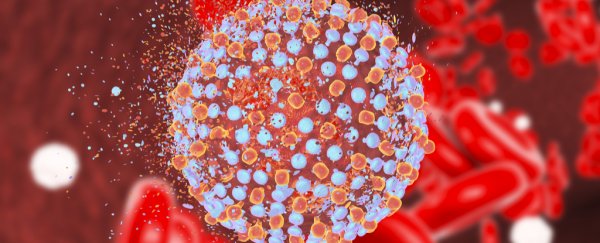ARTICLE AD
 Illustration of hepatitis C virus. (Kateryna Kon/Shutterstock)
Illustration of hepatitis C virus. (Kateryna Kon/Shutterstock)
Demand for hepatitis C tests has surged in the UK following the publication of the infected blood inquiry findings in May 2024.
According to the BBC, "1,750 people in the UK are living with an undiagnosed hepatitis C infection after being given a transfusion with contaminated blood." Globally, there are thousands more unknowingly living with the virus.
So what is this infection, how would you know if you had it – and what can you do about it?
frameborder="0″ allow="accelerometer; autoplay; clipboard-write; encrypted-media; gyroscope; picture-in-picture; web-share" referrerpolicy="strict-origin-when-cross-origin" allowfullscreen>
What is hepatitis C?
Hepatitis C is a type of blood-borne virus that targets the liver, causing inflammation and liver damage if untreated. It spreads between people by blood-to-blood contact.
In cases covered by the infected blood inquiry, infection occurred because patients received treatment products made with blood from people who had the virus.
In other cases, infection can be spread by current or previous intravenous drug use or – typically in places hepatitis C is very common such as in parts of south Asia – by coming into contact with contaminated blood during medical or cosmetic procedures.
Baby boomers – people born between 1945 and 1965 – have higher rates of hepatitis C infection (up to 1 in 30 infected in the US) due to blood transfusions and medical procedures performed before the discovery of the virus.
Globally, about 50 million people are living with hepatitis C and 1 million new infections occur each year. In some people, long-term infection can lead to liver scarring (cirrhosis) and then liver failure and liver cancer, which is responsible for around a quarter of a million deaths per year.
"Transfusion hepatitis" – inflammation of the liver after a person received a blood transfusion – was described in 1969 but it was not until 1989 that hepatitis C was first identified, a discovery that led to the 2020 Nobel prize in medicine.
By 1991, blood donations were routinely screened for the virus in the UK. However, tens of thousands of people had already received blood products contaminated with hepatitis C before this date. This led to many developing long-term infection and thousands going on to die from liver disease.
frameborder="0″ allow="accelerometer; autoplay; clipboard-write; encrypted-media; gyroscope; picture-in-picture; web-share" referrerpolicy="strict-origin-when-cross-origin" allowfullscreen>
What are hepatitis C symptoms?
Hepatitis C is generally a silent infection. At the time of infection, people may experience mild viral symptoms such as tiredness and muscle aches. Occasionally, it can cause jaundice – yellow colour of the eyes and skin. However, most people do not have any symptoms.
The immune system will naturally clear the virus in about three out of every ten people. But for everyone else it becomes a long-term infection that doesn't usually go away without treatment. After about 20 years of infection, many go on to develop liver disease.
Those with long term hepatitis C infection may not suffer with any symptoms and be completely unaware they have the virus. However, vague symptoms such as fatigue, muscle aches and "brain fog" are commonly reported. Brain fog is when people find it hard to concentrate, are forgetful or lack mental clarity.
People with long-term hepatitis C infection may also experience mood changes, depression and anxiety. Only when the liver starts to fail do symptoms become noticeable, including jaundice, swelling with fluid, confusion and vomiting blood.
How can hepatitis C be treated?
Although we've only known about the virus for fewer than 40 years, several highly effective treatments have already been developed and are widely available.
Early treatments involved long courses of injections with many side effects and a low chance of cure. The first tablet treatment was licensed in 2013 and several others came to market shortly after.
These treatments are safe and have few side effects. Currently, eight- to 12-week treatment courses are used across the world with close to 100% cure rate, irrespective of whether the person already has liver damage.
In other words, once identified, it is never too late to cure hepatitis C. After cure, symptoms go away and even in people who have liver scarring, the liver can regenerate and recover.
Progress in treatment has been so good that the World Health Organization announced a global hepatitis elimination strategy, aiming for a 90% reduction in new infections and 65% reduction in deaths by 2030. The UK is ahead of the curve with expected elimination of hepatitis C by 2025.
Once the virus has been found, it can be treated. The challenge remains identifying people who don't know they have the virus.
As part of the country's elimination strategy, the UK government has made available free confidential hepatitis C tests at home. If you want to find out more about hepatitis C and how to get tested visit the Get tested for hepatitis C website.![]()
Ashwin Dhanda, Associate Professor of Hepatology, University of Plymouth
This article is republished from The Conversation under a Creative Commons license. Read the original article.

 7 months ago
52
7 months ago
52 

